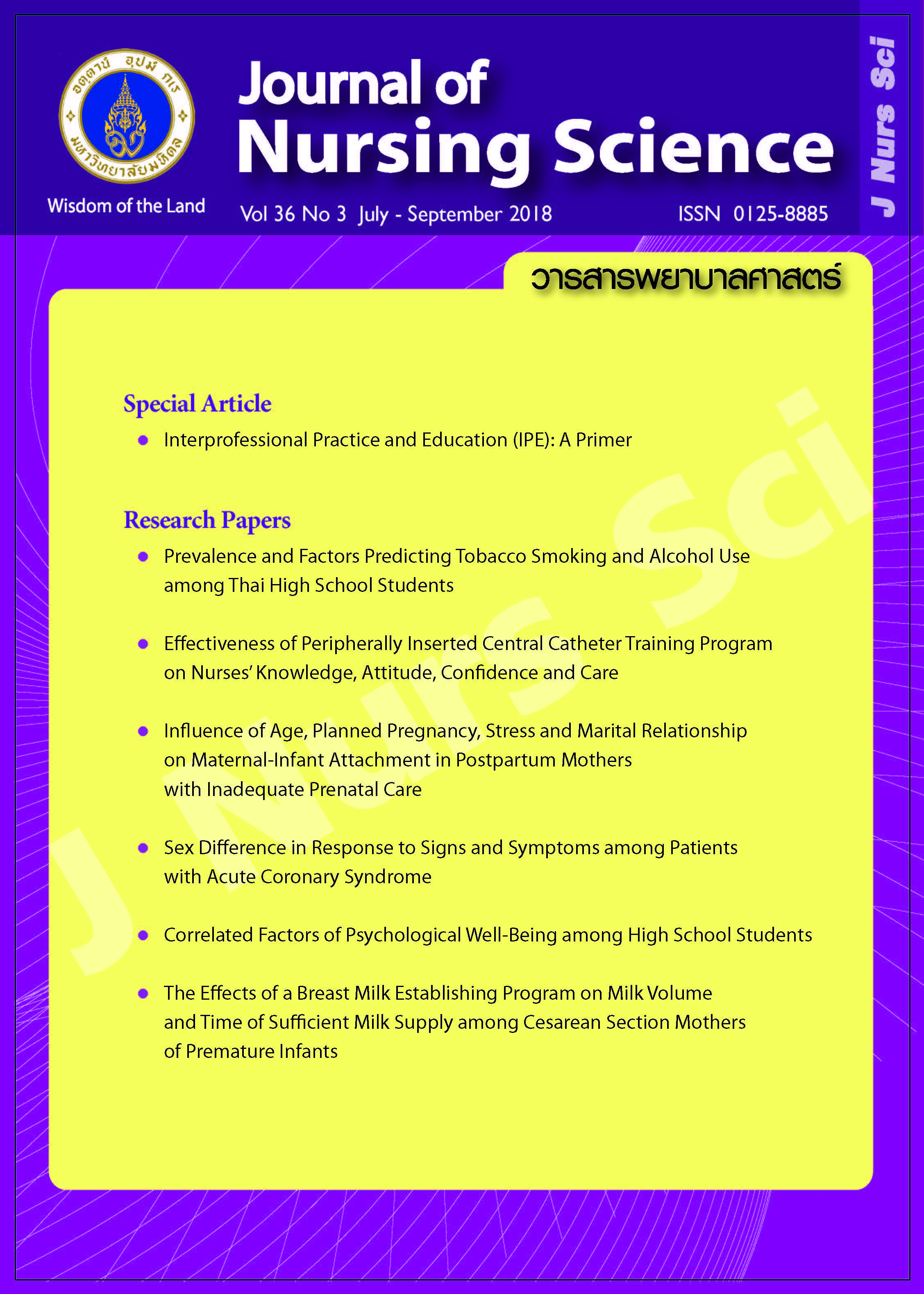Prevalence and Factors Predicting Tobacco Smoking and Alcohol Use among Thai High School Students
Main Article Content
Abstract
Purpose: This study aimed to examine the lifetime prevalence of alcohol and tobacco use in
Thai high school students and determine the relationships between socio-demographic factors and
substances use in Bangkok and Nakorn Pathom.
Design: Descriptive study design.
Method: 624 students from three high schools stratified by grade level were recruited. Data collection included socio-demographics and specific questions from the Alcohol, Smoking and Substance Involvement Screening Test (ASSIST) to examine lifetime use. Data analyses involved descriptive statistics followed by binary logistic regression analysis to create predictive models.
Main findings: Almost ten percent of high school students reported ever smoking tobacco and 34.8% reported ever consuming alcohol. Regression modelling revealed that school type, sex, home structure, parent’s education level, and grade point average (GPA) accounted for 18 % of the variance in predicting alcohol use among the students. However, sex, school type, perceived sufficient income, home structure, and GPA accounted for 15.8% of the variance in predicting tobacco smoking.
Conclusion and recommendations: Alcohol use in this group was relatively low, but the percentage of students smoking tobacco is significantly higher than other countries. These data suggest that increased focus on developing and testing specific tobacco smoking prevention policies, as well as readily available tobacco cessation strategies are imperative to decrease the alarmingly high rates of tobacco smoking reported by students. Further study with larger cohorts of high school students is needed to confirm the lifetime prevalence of tobacco smoking reported here and to gather longitudinal surveillance data on the prevalence of continued smoking into adulthood.
Article Details
Copyright Notice: Nursing Science Journal of Thailand has exclusive rights to publish and distribute the manuscript and all contents therein. Without the journal’s permission, the dissemination of the manuscript in another journal or online, and the reproduction of the manuscript for non-educational purpose are prohibited.

Disclaimer: The opinion expressed and figures provided in this journal, NSJT, are the sole responsibility of the authors. The editorial board bears no responsibility in this regard.
References
2. Burrus BB, Krieger K, Rutledge R, Rabre A, Axelson S, Miller A, et al. Building bridges to a brighter tomorrow: a systematic evidence review of interventions that prepare adolescents for adulthood. Am J Public Health. 2018;108 Suppl 1:25-31.
3. National Statistical Ofice. The smoking and drinking behavior survey [Internet]. Bangkok: National Statistical Office;
2014 [cited 2018 Aug 3]. Available from: https://service.nso.go.th/nso/nsopublish/themes/files/smokeFullReport57-1.pdf.
4. Steketee M, Jonkman H, Berten H, Vettenburg N, editors. Alcohol use among adolescents in Europe: environmental research and preventive actions. Utrecht: Verwey-Jonker Instituut; 2013 [cited 2018 Aug 3]. Available from: https://www.verweyjonker.nl/doc/participatie/2708_Alcohol-use-Among-Adolescents-in-Europe.pdf.
5. Kwon HK, Greenson JK, Conjeevaram HS. Effect of lifetime alcohol consumption on the histological severity of non-alcoholic fatty liver disease. Liver Int. 2014;34(1):129-35.
6. Chung SS, Joung KH. Risk factors for smoking behaviors among adolescents. J Sch Nurs. 2014;30(4):262-71.
7. Karimi M, Kaveh MH, Morowatisharifabad MA, Dehghani A, Dastjerdi G. Cigarette smoking experience and its related sociodemographic and environmental risk factors in high school boy students, Shiraz- Iran. International Journal of Pediatric. 2017;5(2):4263-74.
8. Lovato C, Watts A, Brown KS, Lee D, Sabiston C, Nykiforuk C, et al. School and community predictors of smoking:
a longitudinal study of Canadian high schools. Am J Public Health. 2013;103(2):362-8.
9. Vaughan EL, Chang TK, Escobar OS, de Dios MA. Enrollment in Hispanic serving institutions as a moderator of
the relationship between drinking norms and quantity of alcohol use among hispanic college students. Subst Abus. 2015;36(3):314-7.
10. Wang J, Simons-Morton BG, Farhat T, Luk JW. Socio-demographic variability in adolescent substance use: mediation by parents and peers. Prev Sci. 2009;10(4):387-96.
11. Kim J, Sohn A. Smoking and alcohol drinking related to experience of harmful sops among Korean adolescents. Osong Public Health Res Perspect. 2014;5(3):138-47.
12. Rozi S, Butt ZA, Zahid N, Wasim S, Shafique K. Association of tobacco use and other determinants with pregnancy outcomes: a multicenter hospital-based case-control study in Karachi, Pakistan. BMJ Open. 2016;6(9):e012045. doi: 10.1136/bmjopen-2016-012045. PubMed PMID: 27650766; PubMed Central PMCID: PMC5051420.
13. Saingam D, Assanangkornchai S, Geater AF. Drinking-smoking status and health risk behaviors among high school students in Thailand. J Drug Educ. 2012;42(2):177-93.
14. WHO ASSIST Working Group. The Alcohol, Smoking and Substance Involvement Screening Test (ASSIST): development, reliability and feasibility. Addiction. 2002;97(9):1183-94.
15. Humeniuk R, Ali R, Babor T, Souza-Formigoni ML, de Lacerda RB, Ling W, et al. A randomized controlled trial of a brief intervention for illicit drugs linked to the Alcohol, Smoking and Substance Involvement Screening Test (ASSIST) in clients recruited from primary health-care settings in four countries. Addiction. 2012;107(5):957-66.
16. Newcombe DA, Humeniuk RE, Ali R. Validation of the World Health Organization Alcohol, Smoking and
Substance Involvement Screening Test (ASSIST): report of results from the Australian site. Drug Alcohol Rev. 2005;24(3):217-26
17. Field A. Discovering Statistics Using IBM SPSS Statistics. 4th ed. Thousand Oaks, CA : SAGE Publications; 2013.
18. Liu J, Zhao S, Chen X, Falk E, Albarracin D. The influence of peer behavior as a function of social and cultural closeness: a meta-analysis of normative influence on adolescent smoking initiation and continuation. Psychol Bull. 2017;143(10):1082-115.
9. Erol A, Karpyak VM. Sex and gender related differences in alcohol use and its consequences: contemporary knowledge and future research considerations. Drug Alcohol Depend. 2015;156:1-13.
20. Laslett A, Jiang H, Room R. Alcohol consumption of australian parents: continuity and change in the new millennium [Internet]. Melbourne, VIC: Centre for Alcohol Policy Research, School of Psychology and Public Health; 2017 [cited 2018 Aug 3]. Available from: https://fare.org.au/wpcontent/uploads/Alcoholconsumption-of-Australian-parents-FINAL-30-JUNE-2017.pdf.
21. Pedrelli P, Shapero B, Archibald A, Dale C. Alcohol use and depression during adolescence and young adulthood: a summary and interpretation of mixed findings. Curr Addict Rep. 2016;3(1):91-7.
22. Sung DJ, So WY, Jeong TT. Association between alcohol consumption and academic achievement: a crosssectional study. Cent Eur J Public Health. 2016;24(1):45-51.


